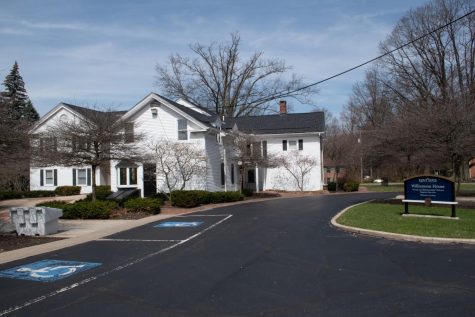Cultural trifecta
April 26, 2007
At age 17, Kent State student has experienced three different cultures
WILL SCHERTZ | DAILY KENT STATER
Don Swekoski, junior English literature major, jokes around with freshman pre-med major Sabina Socias after lunch. The two have been dating for about a month.
Credit: Adam Griffiths
When Sabina Socias speaks, it’s apparent from her accent that English is not her native tongue, but it’s hard to decide what language to associate with it.
Having moved back and forth between Barcelona and Paris as a child, she quickly acquired both French and Spanish languages, as well as both dialects. She admits she often combines the two languages when speaking to her parents, though she tends to use French more often.
At age 17, Socias, freshman pre-med major, has lived in three different countries, learned three languages and seen more culturally diverse environments than most will see in a lifetime.
When she was 13, her father, who is involved in sales and marketing with an international company, moved her family to the United States to work for a new division in North Canton.
“When I first moved here I didn’t speak any English,” she said, adding it made her feel out of place in an English-speaking high school.
Despite initial troubles with communication, Socias said she became effective at using the language by the end of her first semester. While she was learning, other students were kind to her and showed interest in her culture, she said.
“Americans are very welcoming,” she said. “I wasn’t expecting all the interest. Everyone wanted to learn about me.”
Coming from a slow-paced European society, it was a stretch adapting to American culture. One result of living in a fast-paced society like the United States, she said, is that it can take away from spending quality time with family – something very important in her culture.
“In Europe we have meals with the family every night, but here it’s always a rush,” she said. “This is a very hectic society.”
Though her family has adapted to the American way of life, they have also kept many of their own culture’s practices.
The family celebrates many of the same holidays as people in the United States, such as Christmas and Easter, but they also celebrate individual saints as well. Socias said each day is associated with a different saint.
One celebration unique to the province of Catalonia – which is home to Barcelona – is Saint Jordi, which Socias said is an equivalent to Valentine’s Day in the United States.
On Saint Jordi’s feast day, men buy roses for the women they like, while women buy books for the men.
“There’s books everywhere,” Socias said. “People are lined up in the streets selling them. It’s very nice.”
Other subtle differences exist between American and European society, such as the issue of what happens to a woman’s maiden name when she gets married.
In the United States, a woman traditionally drops her maiden name and takes on the last name of her husband; in Spain, women simply acquire a second last name.
Socias’ last name from her mother’s side is Garcia. In Spain the husband’s last name comes first, though Socias said parents may be able to make that decision for themselves in the future.
One benefit Socias finds from living in Ohio is that it is more diverse than her home country, both racially and otherwise.
“I find people to be more open-minded over here,” she said. “There’s a lot of diversity here too, which I like. Everyone is very uniform in Europe.”
Socias also enjoys eating at ethnic restaurants, which she said are rare in Barcelona. Most restaurants in Spain serve only Spanish cuisine, while the United States has a variety of different restaurants.
Socias said she enjoys living in the United States, but the relaxed feel of her home town is still very special to her. She plans to move back to Europe when she graduates.
“Barcelona is a very warm city,” she said. “In general people are more laid back. It’s a very comfortable lifestyle.”
Contact features reporter William Schertz at [email protected].
























